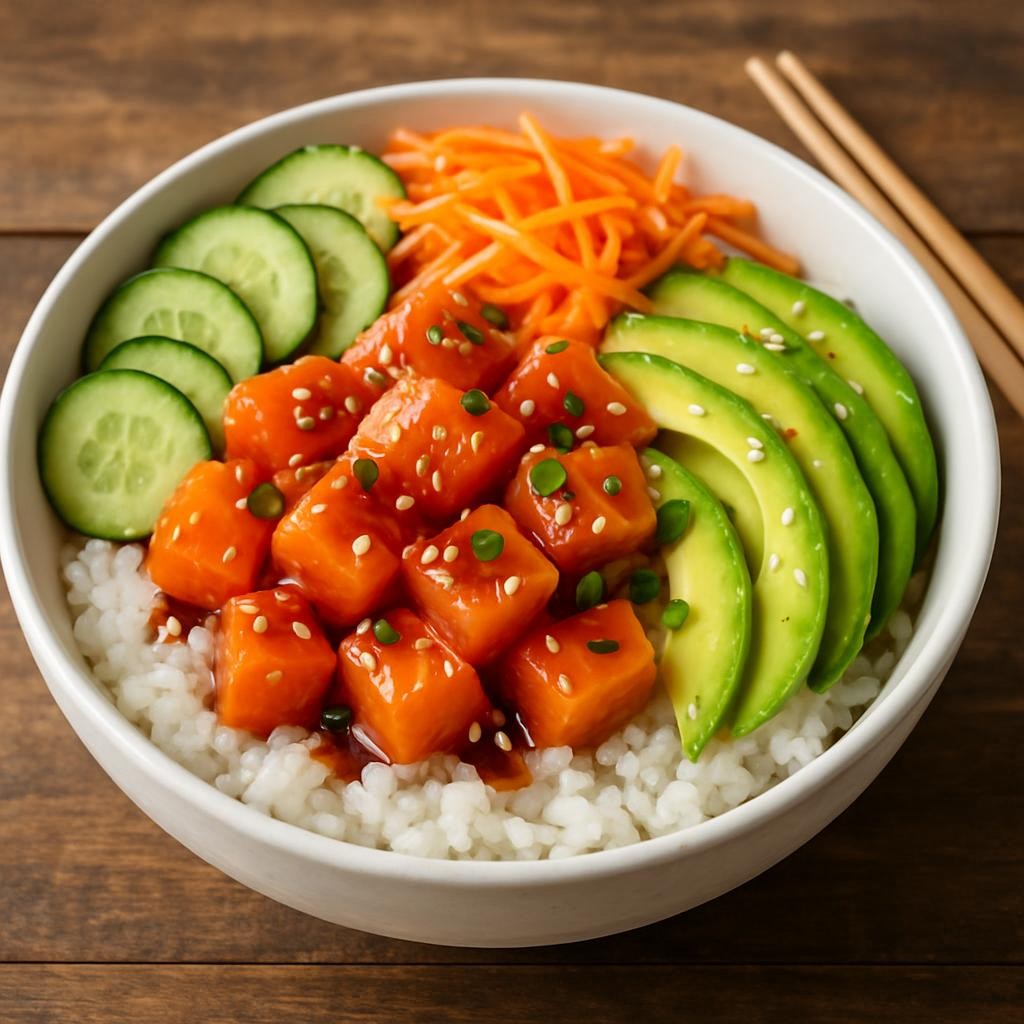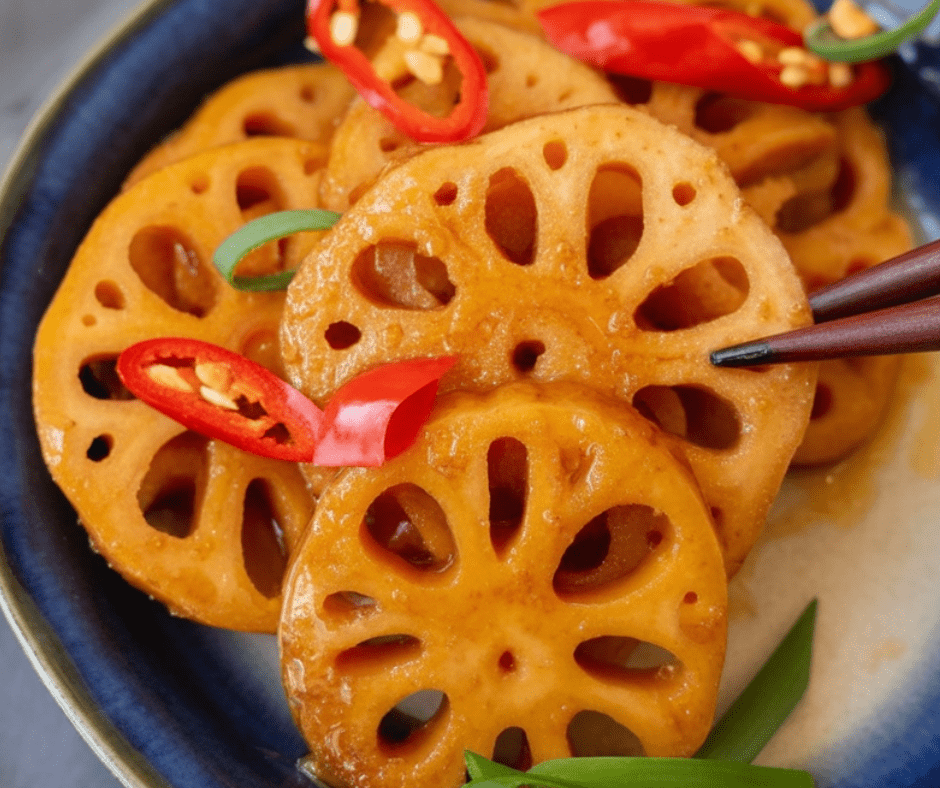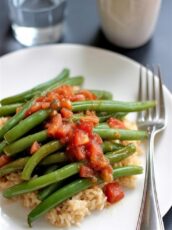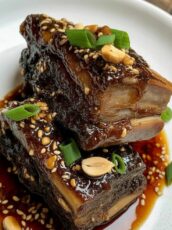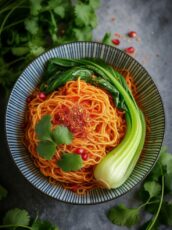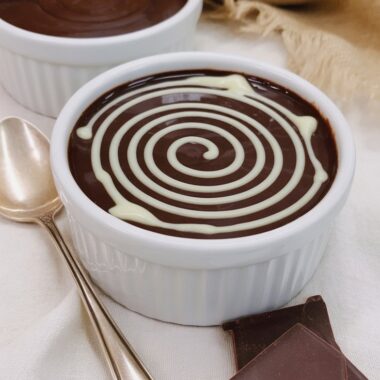Tteokbokki is one of those dishes that instantly reminds me of late-night food cravings and cozy bowls of comforting spice. This Korean street food favorite features chewy rice cakes swimming in a bold, sweet-spicy sauce made with gochujang. Whether you like it simple or loaded with extras like ramen, eggs, or melty cheese, this version is easy to make and always satisfying.

What is Tteokbokki?
Tteokbokki , sometimes spelled ddeokbokki or ddukbokki, literally means “stir-fried rice cakes.” The base of the dish is made using garae-tteok—long, cylindrical rice cakes that become wonderfully soft and chewy once cooked.
The classic tteokbokki you find at Korean street stalls features these rice cakes simmered in a rich, gochujang-based sauce that’s both spicy and slightly sweet. You can adjust the sauce to be brothy or thick and glossy depending on your taste. Plus, the add-ins are totally up to you—fish cakes, boiled eggs, instant noodles, dumplings, or even a handful of cheese for that perfect creamy finish.
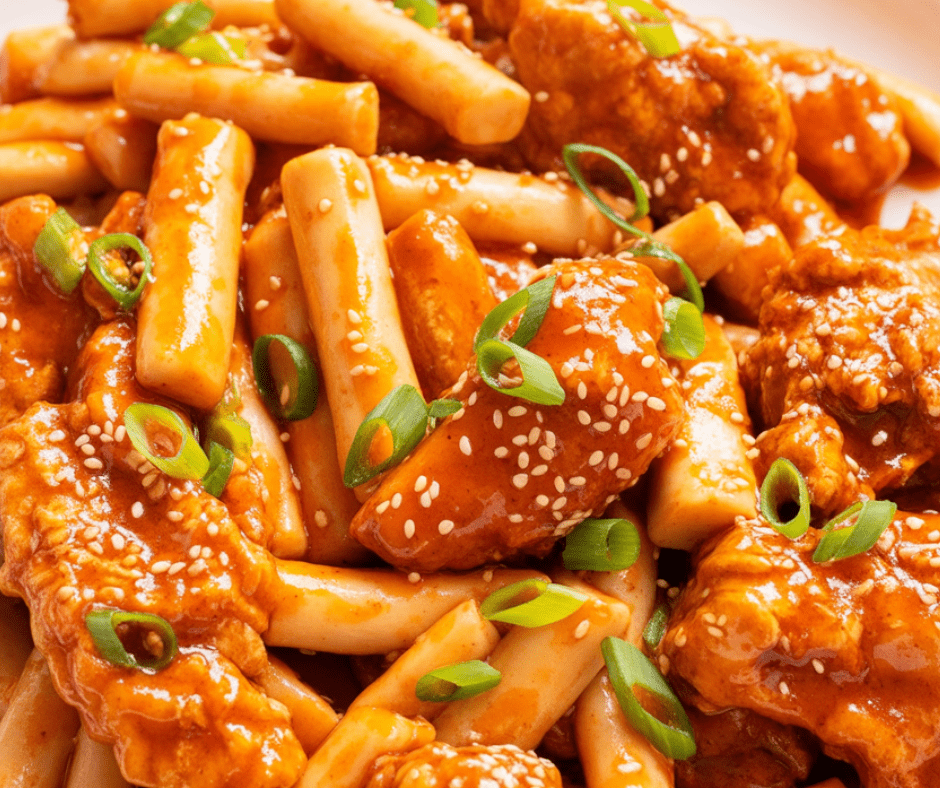
Ingredients You’ll Need
Here’s what goes into this spicy, saucy bowl of goodness:
- Korean rice cakes (garae-tteok): Look for these vacuum-packed in the refrigerated or frozen section at Korean or Asian grocery stores.
- Anchovy stock packet: This adds deep umami to the base. If you can’t find it, substitute with water, chicken stock, or vegetable stock.
- Gochujang (Korean red pepper paste): The heart of the sauce—it’s spicy, salty, a little sweet, and packed with flavor.
- Gochugaru (Korean red pepper flakes): Adds extra kick and that vibrant red color. Try not to substitute it with regular chili flakes—Korean dishes really benefit from its unique flavor.
- Soy sauce, sugar, and garlic: These balance out the heat and add a savory-sweet punch.
- Fish cakes (optional): Traditional and delicious, but you can skip for a vegetarian version.
- Optional toppings: Boiled eggs, cooked ramen noodles, mandu (Korean dumplings), or shredded cheese.
- Toasted sesame oil, sesame seeds, scallions: Add these at the end for a fragrant and tasty finish.
Let’s Make Tteokbokki
Here’s how you can whip this up at home in under 30 minutes:
1. Make the Sauce
In a small bowl, stir together gochujang, gochugaru, soy sauce, garlic, and sugar until it becomes a thick, spicy-sweet paste. Set it aside so the flavors can meld while you prep the rest.
2. Prepare the Stock
In a wide, deep pan, bring water to a boil along with the anchovy stock packet. Once it’s bubbling away, discard the packet and stir in the spicy sauce mixture. If you’re using plain water or vegetable stock, just bring it to a boil and proceed.
3. Cook the Rice Cakes
Add the rice cakes straight into the bubbling sauce along with sliced fish cakes (if using). If you’ve got veggies like cabbage or carrots, now’s a good time to toss them in too. Let it all simmer for 5 to 7 minutes until the rice cakes soften and the sauce thickens.
4. Add the Extras
Once your base is ready, throw in any extra goodies—boiled eggs, cooked mandu, or ramen noodles. If you’re adding ramen, you may need a splash more water or stock. Feeling indulgent? Stir in some shredded cheese and let it melt right in.
5. Finish with Flavor
Drizzle a bit of toasted sesame oil over the top, sprinkle some sesame seeds, and scatter chopped scallions for that final pop of freshness.

Variations You Can Try
Here are a few fun ways to customize your tteokbokki bowl:
- Hard boiled eggs: A must-have for traditional versions.
- Mandu (dumplings): Toss in pre-steamed dumplings at the end for added texture.
- Shredded cheese: Adds a creamy contrast to the spicy sauce.
- Ramen noodles: Make it a full-on meal—just remember to add more broth if needed.
Frequently Asked Questions
Where can I find tteokbokki rice cakes?
Look for garae-tteok in Korean or Asian grocery stores. They’re usually packed in plastic and stored in the fridge or freezer. Each piece is about 2–3 inches long and shaped like little tubes.
Can I store leftovers?
Yes! Pop any leftovers into an airtight container and refrigerate for up to 3 days. Keep in mind the rice cakes will firm up once cold.
How do I reheat tteokbokki?
Microwave it for about a minute with a splash of water to loosen up the sauce and soften the rice cakes. Stir well before serving.
What’s in the tteokbokki sauce?
Traditional tteokbokki sauce is made from gochujang, gochugaru, soy sauce, sugar, garlic, and anchovy stock. If you don’t have anchovy stock, feel free to swap it with water or another broth.
How to Serve Tteokbokki
Serve your tteokbokki piping hot straight from the pan. It’s great as a snack, late-night comfort meal, or even a hearty lunch. Pair it with pickled radish (danmuji) to balance the heat or a chilled Korean barley tea.
Korean Rice Cakes - Tteokbokki

This quick and easy tteokbokki recipe features chewy Korean rice cakes simmered in a bold, sweet and spicy gochujang sauce! Customize it with ramen noodles, melty cheese, fish cakes, or eggs for an extra kick.
Ingredients
- 1 lb rice cakes – about 2 ½ cups
- 1 cup fish cakes – sliced into bite-sized pieces
- 2 teaspoons toasted sesame oil
- 1 tablespoon sesame seeds
- 2 scallions – chopped
Tteokbokki Sauce
- 3 cups water or anchovy broth – see Note 1
- 3 tablespoons gochujang (Korean red pepper paste)
- 1½ tablespoons sugar
- 1½ tablespoons soy sauce
- 1tablespoon gochugaru (Korean red pepper flakes)
- 2 cloves garlic – minced
Optional Add-Ins
- 2 hard-boiled eggs
- 1 cup chopped vegetables (like cabbage, carrots, onions)
- ½ cup shredded cheese
- Pre-cooked ramen noodles
Instructions
- Make the sauce:In a small bowl, mix gochujang, gochugaru, sugar, soy sauce, and minced garlic. Set aside.3 tbsp gochujang, 1 tbsp gochugaru, 1½ tbsp sugar, 1½ tbsp soy sauce, 2 cloves garlic
- Combine ingredients:Bring the water or anchovy stock to a boil in a large pan. Stir in the tteokbokki sauce, rice cakes, fish cakes, and optional vegetables.1 lb rice cakes, 3 cups stock or water, 1 cup fish cakes
- Cook everything:Simmer over medium heat for 5 to 7 minutes, or until the rice cakes soften and the sauce thickens. Add more water or stock as needed to adjust consistency.
- Finish and serve:Taste and tweak if needed – more sugar or soy sauce if desired. Drizzle with sesame oil and top with scallions and sesame seeds.Add in pre-cooked noodles, eggs, or sprinkle cheese on top if using. Enjoy!2 tsp sesame oil, 1 tbsp sesame seeds, 2 scallions
Notes
- Anchovy Stock: To prepare anchovy broth, combine 3 cups water with 1 anchovy flavoring packet in a pot. Bring to a boil, then discard the packet. Store in the fridge in an airtight container for up to 3 days.
- Spice Level Tips: Both gochujang and gochugaru come in different heat levels (mild to hot). Check the packaging or ask your local Asian or Korean market to find your preferred level of heat.
Nutrition Information:
Yield: 4 Serving Size: 1Amount Per Serving: Calories: 976Total Fat: 24gSaturated Fat: 8gTrans Fat: 0gUnsaturated Fat: 14gCholesterol: 142mgSodium: 2254mgCarbohydrates: 159gFiber: 10gSugar: 16gProtein: 31g
Asianplated.com, occasionally offers nutritional information for recipes contained on this site. This information is provided as a courtesy and is an estimate only. This information comes from online calculators. Although allchickenrecipes.com attempts to provide accurate nutritional information, these figures are only estimates.
Storing and Reheating Tips
- To store: Place any leftovers in an airtight container in the fridge for up to 3 days.
- To reheat: Microwave with a splash of water or reheat gently on the stovetop. The rice cakes will soften again as they warm up.
Try other korean recipes:

